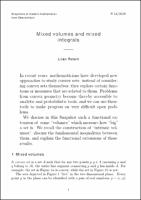| dc.contributor.author | Rotem, Liran | |
| dc.contributor.editor | Jahns, Sophia | |
| dc.contributor.editor | Cederbaum, Carla | |
| dc.date.accessioned | 2019-01-29T08:24:15Z | |
| dc.date.available | 2019-01-29T08:24:15Z | |
| dc.date.issued | 2018-12-29 | |
| dc.identifier.uri | http://publications.mfo.de/handle/mfo/1400 | |
| dc.description.abstract | In recent years, mathematicians have developed new
approaches to study convex sets: instead of considering
convex sets themselves, they explore certain functions
or measures that are related to them. Problems
from convex geometry become thereby accessible to
analytic and probabilistic tools, and we can use these
tools to make progress on very difficult open problems.
We discuss in this Snapshot such a functional extension
of some “volumes” which measure how “big”
a set is. We recall the construction of “intrinsic volumes”,
discuss the fundamental inequalities between
them, and explain the functional extensions of these
results. | en_US |
| dc.language.iso | en | en_US |
| dc.publisher | Mathematisches Forschungsinstitut Oberwolfach | en_US |
| dc.relation.ispartofseries | Snapshots of modern mathematics from Oberwolfach;2018,14 | |
| dc.rights | Attribution-ShareAlike 4.0 International | * |
| dc.rights.uri | http://creativecommons.org/licenses/by-sa/4.0/ | * |
| dc.title | Mixed volumes and mixed integrals | en_US |
| dc.type | Article | en_US |
| dc.identifier.doi | 10.14760/SNAP-2018-014-EN | |
| local.series.id | SNAP-2018-014-EN | en_US |
| local.subject.snapshot | Analysis | en_US |
| local.subject.snapshot | Geometry and Topology | en_US |
| dc.identifier.urn | urn:nbn:de:101:1-2019013111201793399338 | |
| dc.identifier.ppn | 1653769378 | |


